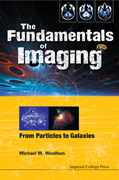
It is through images that we understand the form and function of material objects, from the fundamental particles that are the constituents of matter to galaxies that are the constituents of the Universe. Imaging must be thought of in a flexible way as varying from just the detection of objects — a blip on a screen representing an aircraft or a vapour trail representing the passage of an exotic particle — to displaying the fine detail in the eye of an insect or the arrangement of atoms within or on the surface of a solid. The range of imaging tools, both in the type of wave phenomena used and in the devices that utilize them, is vast. This book will illustrate this range, with wave phenomena covering the entire electromagnetic spectrum and ultrasound, and devices that vary from those that just detect the presence of objects to those that image objects in exquisite detail. The word ‘fundamentals’ in the title has meaning for this book. There will be no attempt to delve into the fine technical details of the construction of specific devices but rather the book aims to give an understanding of the principles behind the imaging process and a general account of how those principles are utilized. INDICE: The Human Visual System: The Optical System; The Photoreceptors; The Way that Nerve Cells Operate and Communicate; The Neural Network of the Eye; The Visual Cortex; The Evolution of the Eye: Plants and Light; Different Forms of Eye; The Evolution of the Vertebrate Eye; Waves and Image Formation: What is Light?; Huygens' Wavelets; Reflection and Refraction; Stereoscopy; Holography; Seeing Small Objects: Resolution of the Visual System; Simple Microscope— the Magnifying Glass; The Compound Microscope; Phase-Contrast Microscopy; Electron Microscopy; Photography and the Recording of Images: The Origins of the Camera; Recording and Storing Monochrome Images; The Beginning of Colour Photography; Modern Colour Photography; The Basic Construction of a Camera; Digital Cameras; Detecting and Imaging with Infrared Radiation: The Radiation from Hot Bodies; The Detection of Infrared Radiation; Infrared Imaging; Radar: The Origin of Radar; Determining the Distance; The Basic Requirements of a Radar System; Generators of Radio Frequency Radiation; Transmitting the Pulses; Reception and Presentation; Doppler Radar; Synthetic Aperture Radar; Other Radar Applications; Imaging the Universe with Visible and Near-Visible Radiation: Optical Telescopes; Refracting Telescopes; Reflecting Telescopes; Infrared Astronomy; Adaptive Optics; Imaging the Universe with Longer Wavelengths: Observations in the Far Infrared; Radio Telescopes; Imaging the Universe with Shorter Wavelengths: Some Aspects of Imaging in the Ultraviolet; X-ray Telescopes; ?-ray Telescopes; Images of the Earth and Planets: Aerial Archaeology; Imaging Earth; Images of Planets; Images for Entertainment: Persistence of Vision; Cinematography; Television; Detection and Imaging with Sound and Vibrations: The Nature of Sound Waves; Animal Echolocation; The Origin of Echolocation Devices; Sonar; Imaging the Interior of the Earth; Medical Imaging: The Discovery of X-rays; X-ray Generators; Recording a Radiographic Image; Computed Tomography — CT Scans; Magnetic Resonance Imaging; Imaging with Ultrasound; Images of Atoms: The Nature of Crystals; The Phenomenon of Diffraction; The Beginning of X-ray Crystallography; X-rays for Diffraction Experiments; The Phase Problem in Crystallography; Determining Crystal Structures; Electron-density Images; The Scanning Tunnelling Microscope; Images of Particles: The Structure of an Atom; Atom-smashing Machines; Many More Particles; Direct Imaging of Particle Tracks.
- ISBN: 978-1-84816-684-4
- Editorial: Imperial College
- Encuadernacion: Cartoné
- Páginas: 376
- Fecha Publicación: 01/09/2011
- Nº Volúmenes: 1
- Idioma: Inglés
